Austrian Wine Country, Where Grüner Veltliner Reigns King
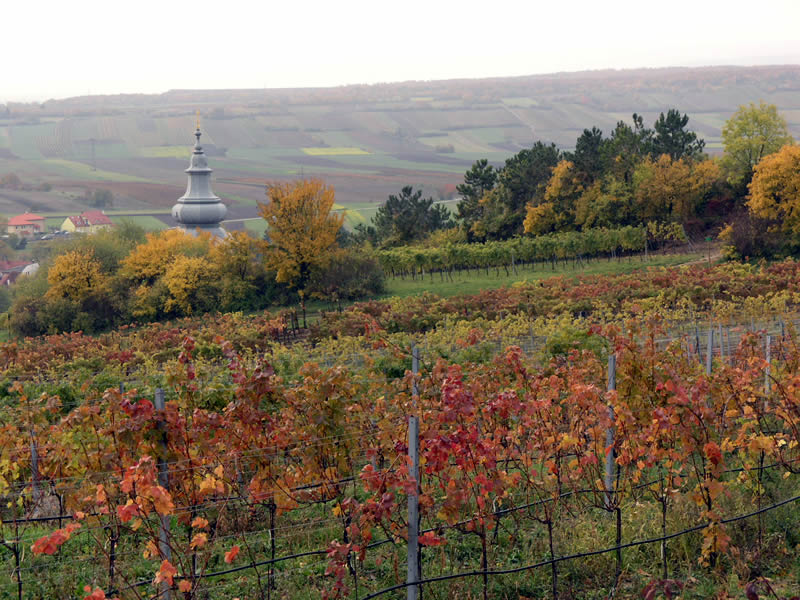
View over Gainfarn, a wine village in Lower Austria. Photo courtesy of Roberto Verzo.
Last week I told you about my sommelier certification course through the Sommelier Society of America on German wine. Part of that class — taught by German wine expert Rudi Eilers — was also on Austrian wine. Austria is a vital region to comprehend for anyone trying to obtain their sommelier certification, as it's not only been producing high-quality wine since at least the 4th century BC (by the Celts), but unique and innovative styles worth exploring. Here, you'll find everything from elegant whites to powerful reds to rich dessert wines, as well as both inexpensive and expensive bottles.
Austria's Main Wine Growing Areas
In Austria wine grapes grow in the East — near to Vienna — as the rest of the country is predominantly mountains. The wine growing region is separated into four main growing areas. Home to over half of Austria's vineyards is Niederösterreich (Lower Austria), encompassing 67,000 acres (27,114 hectares) with five distinct wine districts. Here, along the Danube River, is where you'll find Austria's most important districts for elegant, crisp, dry white wine, including the Wachau, Donauland-Carnuntum and the Kamptal-Donauland.
There's also Burgenland with 32,200 acres (13,030 hectares), making it Austria's second-largest wine region. Along with some powerful reds, this region is known for its botrytis-affected grapes that make sweet ausbruch. According to "The Wine Bible" by Karen MacNeil, this wine is made by mixing botrytized grapes with fresh-press grape must from partially-botrytized grapes. For this wine all grapes come from the same vineyard and are cask aged. Luckily, botrytis does well here due to the mild climate and humidity.
The next in wine growing area in size — and the hilliest — is Steiermark (Styria), with 10,500 acres (4,249 hectares) of undeniable beauty. Nicknamed the "Tuscany of Austria," the idyllic area features wooden windmills, poplar forest, crescent hills and whimsical flower-box adorned farmhouses with pumpkin patches. Here you'll find the country's steepest vineyards filled with different micro-climates. This allows for a variety of wine styles to be produced; however, the most popular is herbacious Sauvignon Blanc and straightforward Morillon (what we know as Chardonnay), as well as an acidic rose known as schilcher produced from Blauer Wildbacher grapes that has intense strawberry aromas.
Lastly, Wien (Vienna) encompasses 1,500 acres (607 hectares) and is the world's only major city classified as a major commercial wine region. Wien is known for its whites, specifically Grüner Veltliner, Riesling, Weiβburgunder (Pinot Blanc) and Chardonnay, as well as a few reds including Zweigelt and Cabernet Sauvignon. According to MacNeil, about one-third of the wines produced in this region are made by planting different varieties of grapes side-by-side in vineyards and picking and pressing them together to create a field blend (not the best quality of wine, but not enjoyable). Typically, wines from Wien aren't sold in stores, but are enjoyed in bars and restaurants.
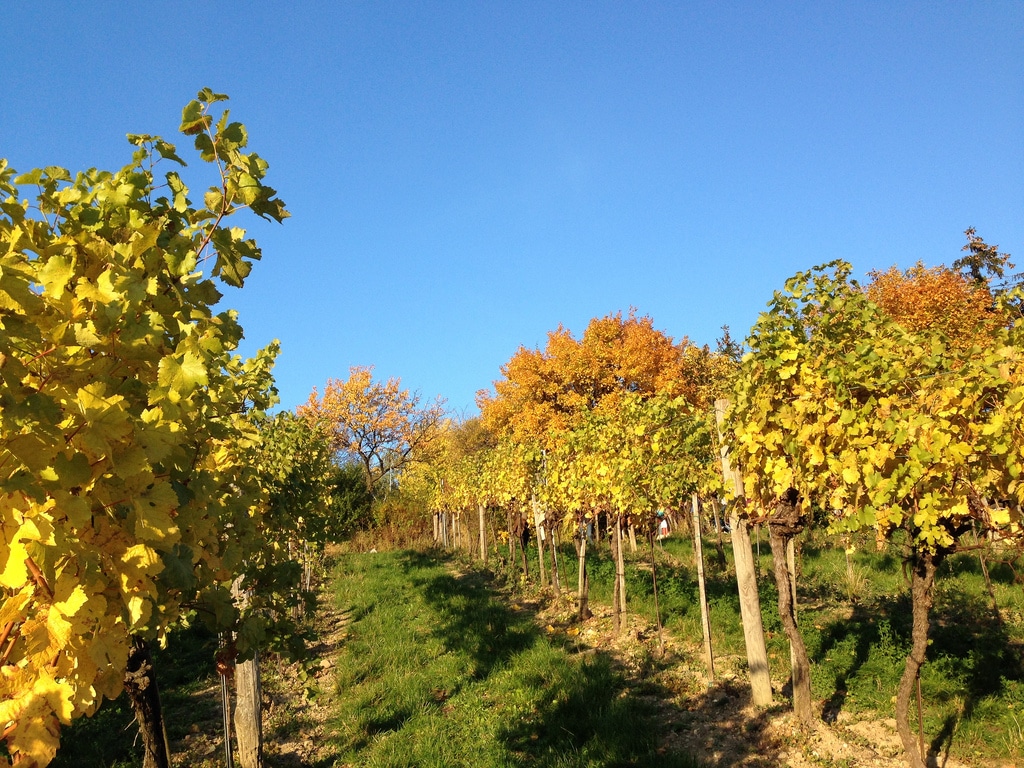
Endless rows of Gruner Vetliner in Austria. Photo courtesy of Andrew Nash.
Austrian Wine Classification
Let's make sure to get one thing straight: Austrian wine is very different from German wine. While Riesling is the most popular grape in Germany, Grüner Veltliner, an aromatic, spicy grape, is the king of Austria. Moreover, while they both focus on dry whites — 80% of Austria's wine production is white — Austria's tend to be fuller bodied. That being said, Austria is similar to Germany in that most of the wines fall under the "quality wines" category. The classification goes like this:
1. National Classification: Very similar to Germany's classification on ripeness — to learn more about this please read our article on German wine. While Germany uses Öchsle to measure ripeness, Austria uses Klosterneuberger Mostwaage (KMW), a measure of the sugar content of grape must to gauge ripeness. One° KMW equals about 5° Öchsle".
The table begins with Tafelwein (at least 10.7°KMW, with grapes being able to come from multiple regions) then moves on to Landwein (at least 14°KMW, 17 grams per liter (g/l) dry extract, 6 g/l residual sugar and 11.5% alcohol) with grapes coming from just one region); Qualitätswein (at least 15°KMW and 9% alcohol with grapes from a single district); and Kabinett (at least 17°KMW Qualitätswein, 12.7% alcohol and g/l residual sugar; no chaptalization is allowed).
From there we get into very high-quality Prädikatswein, a detailed 7-tier regulation system that separates wines by grape must weight (which helps to determine ripeness). These wines are thoroughly tested to see if they are true to their region and scientifically examined, as you'll see from the numbers on the following table. No grape must can be added and no chaptilization performed. From lowest to highest must weight, the table goes:
- Spätlese: At least 19°KMW, with wine not released until after harvest.
- Auslese: At least 21°KMW, with wine made from perfectly-ripened grapes.
- Beerenauslese (BA): At least 25°KMW, with wine made from over-ripe or botrytised grapes. This is where we start to get into dessert wines.
- Ausbruch: At least 27°KMW, with mine made from botrytised grapes.
- Trockenbeerenauslese (TBA): At least 30°KMW, with wine made completely from botrytised grapes for delicious dessert wine.
- Eiswein: At least 25°KMW, with wine made from grapes harvested and pressed while frozen.
- Strohwein or Schilfwein: At least 25°KMW, with wine made from grapes dried on straw mats or reeds for a minimum of three months to concentrate flavor.
Note: This table differs a bit from what you'd find in relation to German wine as in Austria Kabinett is not included in the Prädikatswein category.
2. Wachau Classification: Wachau was the first to establish a wine quality classification system in 1984. This system contains three tiers that rate dry white wines based on their alcohol content. These three tiers include Steinfeder, extra light with a with a maximum of 11.5% alcohol; Federspiel, strongly flavored and between 11.5% and 12.5% alcohol and at least 17° KMW; and Smaragd, a high-quality dry wine containing 12.5% or more alcohol and a maximum of maximum nine grams per liter of residual sugar.
3. Districtus Austriae Controllatus (DAC): This is a newer appellation identical to the French AOC or Italian DOCG systems, based on geography over varietal. Eight out of Austria's 16 wine growing areas — or 50% — have DAC classifications, which have very high quality requirements that vary from region to region. In order to qualify winemakers must impress five out of six blind tasters and convince them the wine fully tells the story of its terroir.
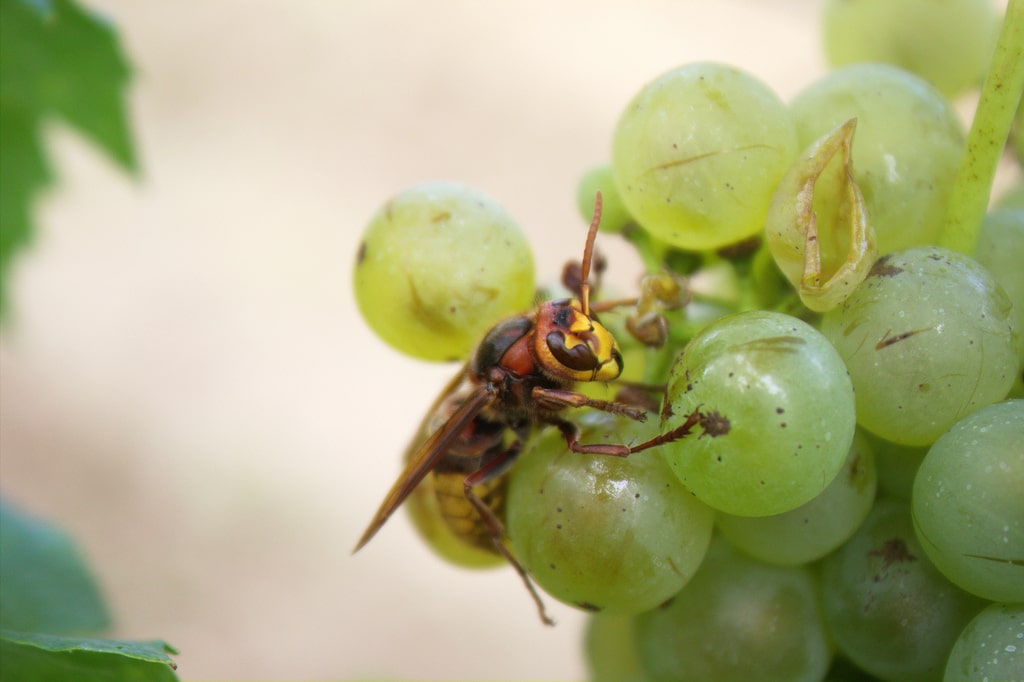
Wine grapes. Photo courtesy of tribp.
The Grapes
In Austria there are over 30 different wine grape varieties grown. That being said, there are five that are of very high significance. We'll start with whites, with the above-mentioned Grüner Veltliner, which makes both dry and sweet wines with flavors of nuts, spice, peach and citrus fruits. Drinkers often note an intense acidity and white pepper spice finish. Another grape of note is Riesling, which, according to Mr. Eilers, is grown in small quantities but produces some of Austria's most fine and expensive wines. Austrian Rieslings can be dry or sweet, and often have strong minerality as well as notes of peach, rose and white pepper. The last white one should understand when discussing Austrian wine is Welschriesling, which makes straightfoward dry wines and, in Burgenland, botrytis-affected dessert wines. Note: This grape is not related to Riesling.
In terms of reds, Blaufränkisch is important, making bold and spicy wines with ripe cherry and dark berry aromas. Moreover, Zweigelt — a cross between Blaufränkisch and St. Laurent — is responsible for 50% of Austria's red wine production and creates powerful wines that are fruity (mainly cherry) and grapey with the ability to age.
Other grapes of significance in Austria include Sauvignon Blanc, Weissburgunder (Pinot Blanc), Furmint, Morillon (Chardonnay), Muskateller, Neuburger, Pinot Gris, Riesling X Sylvaner, Samling and Traminer, which are all white. For reds there's Blauburgunder, Cabernet Sauvignon and St. Laurent.
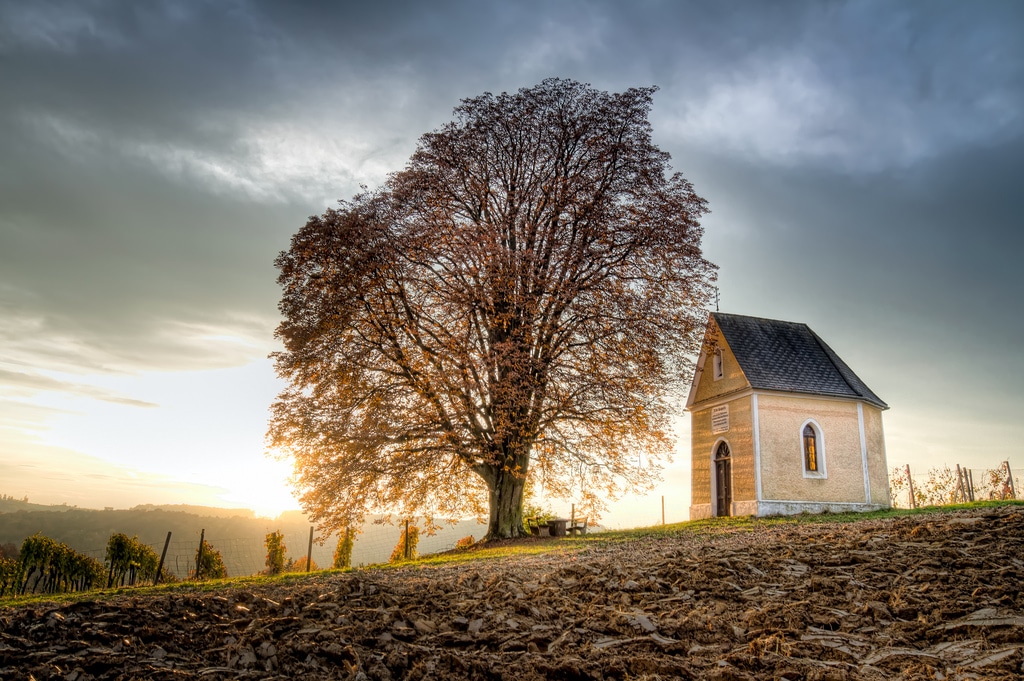
Beautiful Styria at sunset. Photo courtesy of hjjiansch.
The Tasting
Because this sommelier certification class was combined with the German wine class, we sampled only two Austrian wines (the rest were German and Czech). The first was a 2011 Steindorfer St. Laurent Reserve ($34). This wine had an impressive acidity for a red. Made from the St. Laurent grape, it imparted flavors of dark cherry, currant and a hint of spice.
The other Austrian wine the class tried was a 2012 Tegernseerhof "T-26″ Gruner Veltliner Federspiel from the Wachau Valley ($18). With this wine there was an intense minerality with a wet stone quality, with flavors of Granny Smith apple, apricot and spice. It was fatter on the palate than the German wines we had sampled during class, with an impressive length.
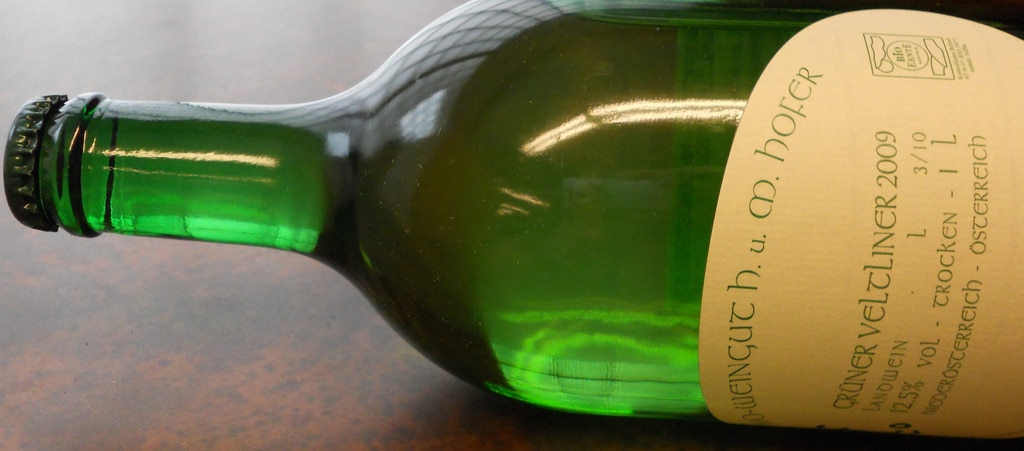
Austrian wine. Photo courtesy of Jameson Fink.
Want more wine? Click here to read previous entries from this Epicure & Culture original series, Sommelier Certification.
Have you explored Austria wine country or savored an Austrian wine you loved? Please share in the comments below.
Also Check Out:
Sommelier Certification: How To Truly Appreciate (And Understand) Champagne
Do You Want To Make Money Traveling The World?
Northern And Southern Rhone: Two Very Different Wine Worlds
The post Sommelier Certification: Austrian Wine Country, Where Grüner Veltliner Reigns King appeared first on Epicure & Culture.